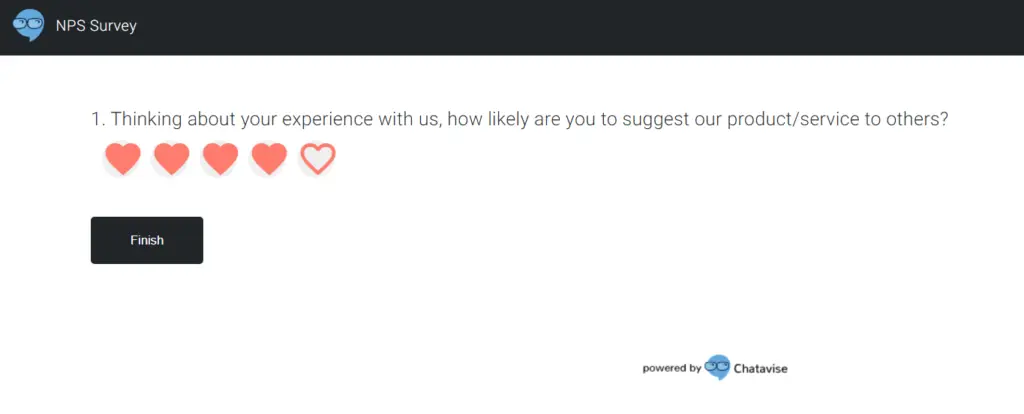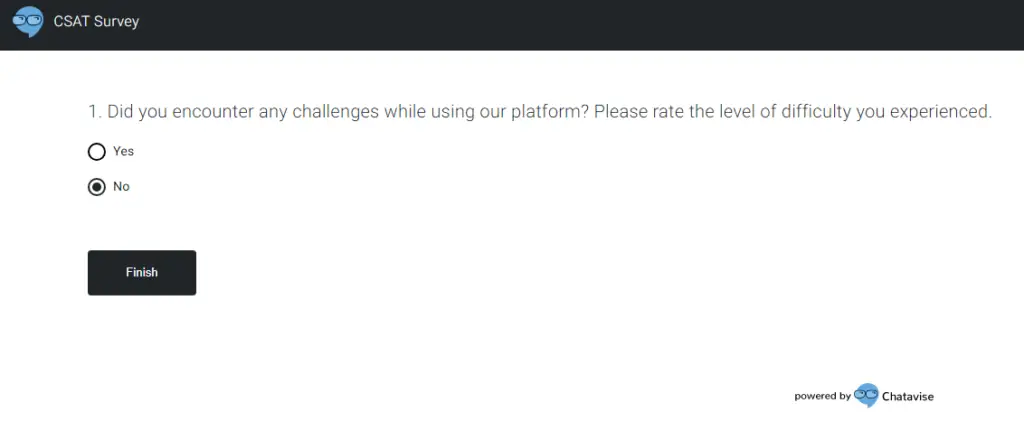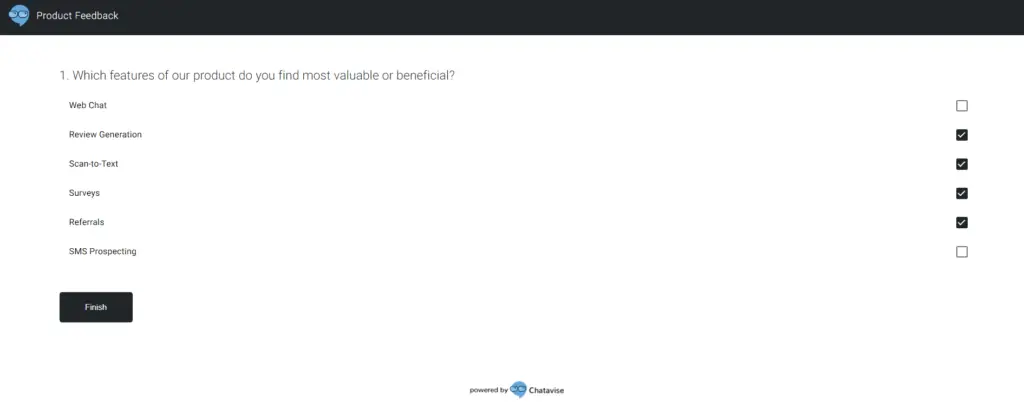How to Choose the Right Survey Type to Enhance Customer Experience
In today’s competitive business landscape, understanding and improving the customer experience is essential for long-term success. One powerful tool that businesses can leverage to gain insights into customer perceptions and preferences is the user feedback survey.
However, with various survey types available, selecting the right one can significantly impact the effectiveness of your efforts. In this article, we’ll explore different survey types and how to choose the most suitable one to enhance the customer experience.
Net Promoter Score (NPS) Surveys
Get ready to witness the pulse of customer loyalty like never before! NPS surveys electrify your senses with a single question, propelling you into the heart of customer advocacy.
According to research by Medallia, companies with high NPS scores tend to have higher customer retention rates and increased profitability compared to those with lower scores (“The Economics of Net Promoter Score,” Medallia, 2021).
NPS surveys are straightforward and can provide a clear benchmark for tracking customer loyalty over time. In addition to measuring overall customer loyalty, consider segmenting NPS survey responses by customer demographics or purchase history. This segmentation can provide deeper insights into which customer segments are most loyal and where improvements are needed.
NPS Examples:
- On a scale of 0 to 10, how likely are you to recommend our product/service to a friend or colleague?
- How likely are you to endorse our brand to others, with 0 being not at all likely and 10 being extremely likely?
- Would you feel comfortable recommending our company to a friend or family member?
- How likely are you to refer our product/service to someone you know, with 0 being not likely at all and 10 being extremely likely?
- Thinking about your experience with us, how likely are you to suggest our product/service to others?

Customer Satisfaction (CSAT) Surveys
Hold on to your hats as CSAT surveys take you on a whirlwind tour of customer delight! With each rating, feel the thrill of victory and the anticipation of improvement. Get ready to conquer satisfaction scores and conquer hearts with every interaction!
According to a study by Qualtrics, companies that prioritize customer satisfaction see higher customer retention rates and increased revenue (“The ROI of Customer Experience,” Qualtrics, 2022).
Implement CSAT surveys at various touchpoints along the customer journey to capture satisfaction levels at each interaction. Analyze trends over time and identify specific areas or processes where satisfaction scores are consistently low for targeted improvement efforts.
CSAT Examples:
- How easy was it to resolve your issue with our customer service team? Please rate on a scale from very difficult to very easy.
- Considering your recent experience with our product/service, how much effort did you have to put forth to accomplish your goal? Please rate from low effort to high effort.
- How much effort did you have to expend to complete your purchase? Please rate on a scale from minimal effort to significant effort.
- Thinking about your interaction with our support team, how much effort did you have to exert to get your question answered? Please rate from effortless to extremely challenging.
- Did you encounter any challenges while using our platform? Please rate the level of difficulty you experienced.

Customer Effort Score (CES) Surveys
Buckle up for the ride of a lifetime as CES surveys pave the way for effortless interactions! Feel the rush of streamlining processes and eliminating obstacles with every effortless rating. Get ready to blaze a trail toward customer loyalty like never before!
Research by Gartner suggests that reducing customer effort can lead to a significant increase in customer loyalty and advocacy (“The Effortless Experience,” Gartner, 2021).
Integrate CES surveys directly into customer service interactions, such as after a support call or chat session. Use real-time feedback to identify friction points in the service delivery process and implement immediate improvements to reduce customer effort.
CES Examples:
- Considering your recent experience with our product/service, how much effort did you have to put forth to accomplish your goal? Please rate from low effort to high effort.
- Did you encounter any challenges while using our platform? Please rate the level of difficulty you experienced.
- How much effort did you have to expend to complete your purchase? Please rate on a scale from minimal effort to significant effort.
- Thinking about your interaction with our support team, how much effort did you have to exert to get your question answered? Please rate from effortless to extremely challenging.
- How easy was it to resolve your issue with our customer service team? Please rate on a scale from very difficult to very easy.

Product Feedback Surveys
Buckle up for the ride of a lifetime as CES surveys pave the way for effortless interactions! Feel the rush of streamlining processes and eliminating obstacles with every effortless rating. Get ready to blaze a trail toward customer loyalty like never before!
According to a report by McKinsey & Company, companies that continuously gather and act upon product feedback see higher levels of customer satisfaction and product innovation (“The Power of Product Feedback,” McKinsey, 2022).
Incorporate product feedback surveys into the product development lifecycle, including beta testing phases and post-launch evaluations. Utilize feedback from customers to prioritize feature enhancements or bug fixes based on customer needs and preferences.
Product Feedback Survey Examples:
- How would you rate the overall usability of our product on a scale from 1 to 10?
- Are there any features or functionalities missing from our product that you would like to see added in the future?
- How satisfied are you with the performance and reliability of our product?
- Please share any additional comments or suggestions you have for improving our product.
- Which features of our product do you find most valuable or beneficial?

Transactional Surveys
Research by Forrester indicates that companies that prioritize real-time transactional feedback experience higher customer satisfaction and loyalty levels (“The Impact of Real-Time Feedback,” Forrester, 2022).
Customize transactional surveys to match the specific context of each interaction, ensuring relevance and specificity in the feedback collected. Implement automated survey delivery mechanisms to streamline the process and capture feedback in real time.
Transactional Survey Examples:
- How satisfied are you with your recent purchase/service interaction? Please rate on a scale from 1 to 5.
- Did our customer service representative resolve your issue to your satisfaction? Please rate from strongly disagree to strongly agree.
- How would you rate the speed and efficiency of our checkout process? Please rate from very slow to very fast.
- On a scale of 1 to 10, how likely are you to make another purchase from us in the future based on your recent experience?
- Please share any feedback or suggestions you have regarding your recent transaction with us.

Full Survey Example

Additional Recommendations:
Align survey objectives with overarching business goals:
- Ensure that the survey type you choose directly contributes to the objectives of your customer experience enhancement efforts.
- Whether you aim to improve overall satisfaction, identify specific pain points, or measure loyalty, selecting the right survey type is crucial for achieving meaningful results.
Consider the target audience and survey context:
- Take into account the characteristics and preferences of your target audience when selecting a survey type.
- Example, if your customers prefer brief, straightforward surveys, consider using NPS or CES surveys.
- Additionally, consider the context in which the survey will be administered, such as the timing and frequency of interactions with your customers.
Evaluate survey frequency and timing:
- Determine the appropriate frequency and timing for survey administration to maximize response rates and minimize survey fatigue.
- For ongoing customer experience monitoring, consider implementing periodic surveys at key touchpoints along the customer journey.
- For transactional surveys, ensure that they are sent promptly after the interaction to capture real-time feedback.
Tailor survey questions and formats:
- Customize survey questions and formats to align with the preferences and expectations of your target audience.
- Use clear, concise language and avoid jargon or complex terminology.
- Consider incorporating a mix of closed-ended and open-ended questions to gather both quantitative and qualitative insights.
Utilize a combination of survey types:
- In many cases, a combination of survey types may be necessary to gain a comprehensive understanding of the customer experience.
- For example, you may use CSAT surveys to measure satisfaction with specific interactions and NPS surveys to assess overall loyalty and advocacy.
- By leveraging multiple survey types, you can capture different aspects of the customer experience and identify opportunities for improvement across various touchpoints.
By carefully considering these recommendations and selecting the most appropriate survey type(s) for your specific objectives and target audience, you can effectively leverage user feedback surveys to enhance the customer experience and drive long-term success for your business.

Ariel Miller
Customer Success Representative
How to Choose the Right Survey Type to Enhance Customer Experience
In today’s competitive business landscape, understanding and improving the customer experience is essential for long-term success. One powerful tool that businesses can leverage to gain insights into customer perceptions and preferences is the user feedback survey.
However, with various survey types available, selecting the right one can significantly impact the effectiveness of your efforts. In this article, we’ll explore different survey types and how to choose the most suitable one to enhance the customer experience.
Net Promoter Score (NPS) Surveys
Get ready to witness the pulse of customer loyalty like never before! NPS surveys electrify your senses with a single question, propelling you into the heart of customer advocacy.
According to research by Medallia, companies with high NPS scores tend to have higher customer retention rates and increased profitability compared to those with lower scores (“The Economics of Net Promoter Score,” Medallia, 2021).
NPS surveys are straightforward and can provide a clear benchmark for tracking customer loyalty over time. In addition to measuring overall customer loyalty, consider segmenting NPS survey responses by customer demographics or purchase history. This segmentation can provide deeper insights into which customer segments are most loyal and where improvements are needed.
NPS Examples:
- On a scale of 0 to 10, how likely are you to recommend our product/service to a friend or colleague?
- How likely are you to endorse our brand to others, with 0 being not at all likely and 10 being extremely likely?
- Would you feel comfortable recommending our company to a friend or family member?
- How likely are you to refer our product/service to someone you know, with 0 being not likely at all and 10 being extremely likely?
- Thinking about your experience with us, how likely are you to suggest our product/service to others?

Customer Satisfaction (CSAT) Surveys
Hold on to your hats as CSAT surveys take you on a whirlwind tour of customer delight! With each rating, feel the thrill of victory and the anticipation of improvement. Get ready to conquer satisfaction scores and conquer hearts with every interaction!
According to a study by Qualtrics, companies that prioritize customer satisfaction see higher customer retention rates and increased revenue (“The ROI of Customer Experience,” Qualtrics, 2022).
Implement CSAT surveys at various touchpoints along the customer journey to capture satisfaction levels at each interaction. Analyze trends over time and identify specific areas or processes where satisfaction scores are consistently low for targeted improvement efforts.
CSAT Examples:
- How easy was it to resolve your issue with our customer service team? Please rate on a scale from very difficult to very easy.
- Considering your recent experience with our product/service, how much effort did you have to put forth to accomplish your goal? Please rate from low effort to high effort.
- How much effort did you have to expend to complete your purchase? Please rate on a scale from minimal effort to significant effort.
- Thinking about your interaction with our support team, how much effort did you have to exert to get your question answered? Please rate from effortless to extremely challenging.
- Did you encounter any challenges while using our platform? Please rate the level of difficulty you experienced.

Customer Effort Score (CES) Surveys
Buckle up for the ride of a lifetime as CES surveys pave the way for effortless interactions! Feel the rush of streamlining processes and eliminating obstacles with every effortless rating. Get ready to blaze a trail toward customer loyalty like never before!
Research by Gartner suggests that reducing customer effort can lead to a significant increase in customer loyalty and advocacy (“The Effortless Experience,” Gartner, 2021).
Integrate CES surveys directly into customer service interactions, such as after a support call or chat session. Use real-time feedback to identify friction points in the service delivery process and implement immediate improvements to reduce customer effort.
CES Examples:
- Considering your recent experience with our product/service, how much effort did you have to put forth to accomplish your goal? Please rate from low effort to high effort.
- Did you encounter any challenges while using our platform? Please rate the level of difficulty you experienced.
- How much effort did you have to expend to complete your purchase? Please rate on a scale from minimal effort to significant effort.
- Thinking about your interaction with our support team, how much effort did you have to exert to get your question answered? Please rate from effortless to extremely challenging.
- How easy was it to resolve your issue with our customer service team? Please rate on a scale from very difficult to very easy.

Product Feedback Surveys
Buckle up for the ride of a lifetime as CES surveys pave the way for effortless interactions! Feel the rush of streamlining processes and eliminating obstacles with every effortless rating. Get ready to blaze a trail toward customer loyalty like never before!
According to a report by McKinsey & Company, companies that continuously gather and act upon product feedback see higher levels of customer satisfaction and product innovation (“The Power of Product Feedback,” McKinsey, 2022).
Incorporate product feedback surveys into the product development lifecycle, including beta testing phases and post-launch evaluations. Utilize feedback from customers to prioritize feature enhancements or bug fixes based on customer needs and preferences.
Product Feedback Survey Examples:
- How would you rate the overall usability of our product on a scale from 1 to 10?
- Are there any features or functionalities missing from our product that you would like to see added in the future?
- How satisfied are you with the performance and reliability of our product?
- Please share any additional comments or suggestions you have for improving our product.
- Which features of our product do you find most valuable or beneficial?

Transactional Surveys
Research by Forrester indicates that companies that prioritize real-time transactional feedback experience higher customer satisfaction and loyalty levels (“The Impact of Real-Time Feedback,” Forrester, 2022).
Customize transactional surveys to match the specific context of each interaction, ensuring relevance and specificity in the feedback collected. Implement automated survey delivery mechanisms to streamline the process and capture feedback in real time.
Transactional Survey Examples:
- How satisfied are you with your recent purchase/service interaction? Please rate on a scale from 1 to 5.
- Did our customer service representative resolve your issue to your satisfaction? Please rate from strongly disagree to strongly agree.
- How would you rate the speed and efficiency of our checkout process? Please rate from very slow to very fast.
- On a scale of 1 to 10, how likely are you to make another purchase from us in the future based on your recent experience?
- Please share any feedback or suggestions you have regarding your recent transaction with us.

Full Survey Example

Additional Recommendations:
Align survey objectives with overarching business goals:
- Ensure that the survey type you choose directly contributes to the objectives of your customer experience enhancement efforts.
- Whether you aim to improve overall satisfaction, identify specific pain points, or measure loyalty, selecting the right survey type is crucial for achieving meaningful results.
Consider the target audience and survey context:
- Take into account the characteristics and preferences of your target audience when selecting a survey type.
- Example, if your customers prefer brief, straightforward surveys, consider using NPS or CES surveys.
- Additionally, consider the context in which the survey will be administered, such as the timing and frequency of interactions with your customers.
Evaluate survey frequency and timing:
- Determine the appropriate frequency and timing for survey administration to maximize response rates and minimize survey fatigue.
- For ongoing customer experience monitoring, consider implementing periodic surveys at key touchpoints along the customer journey.
- For transactional surveys, ensure that they are sent promptly after the interaction to capture real-time feedback.
Tailor survey questions and formats:
- Customize survey questions and formats to align with the preferences and expectations of your target audience.
- Use clear, concise language and avoid jargon or complex terminology.
- Consider incorporating a mix of closed-ended and open-ended questions to gather both quantitative and qualitative insights.
Utilize a combination of survey types:
- In many cases, a combination of survey types may be necessary to gain a comprehensive understanding of the customer experience.
- For example, you may use CSAT surveys to measure satisfaction with specific interactions and NPS surveys to assess overall loyalty and advocacy.
- By leveraging multiple survey types, you can capture different aspects of the customer experience and identify opportunities for improvement across various touchpoints.
By carefully considering these recommendations and selecting the most appropriate survey type(s) for your specific objectives and target audience, you can effectively leverage user feedback surveys to enhance the customer experience and drive long-term success for your business.

Ariel Miller
Customer Success Representative
